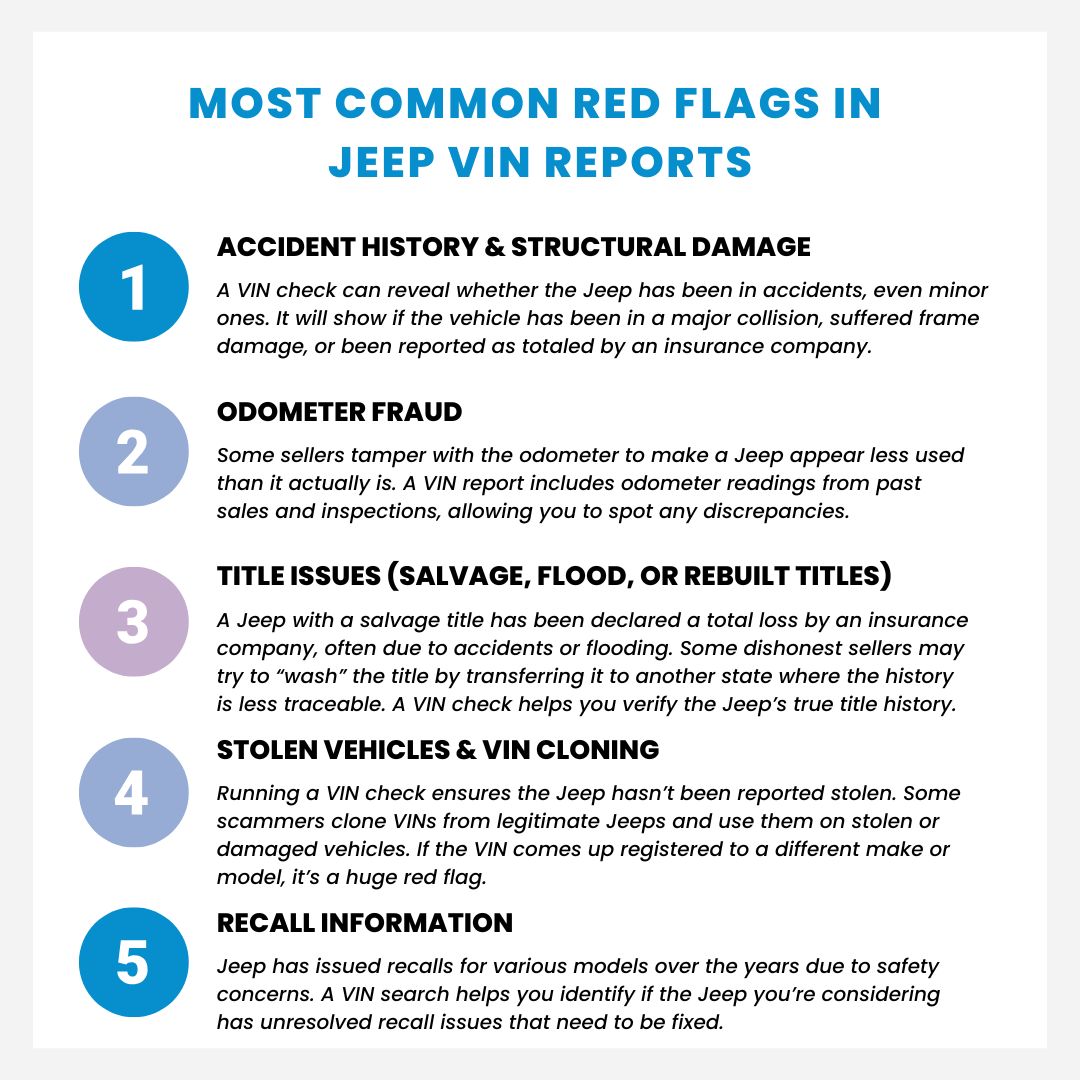Buying a used Jeep can be an exciting experience, whether you’re after the rugged Wrangler, the powerful Grand Cherokee, or the versatile Compass. But beneath the hood, a vehicle’s history could be hiding serious issues that might cost you thousands in repairs. That’s why decoding a Jeep VIN before purchasing is crucial—it helps you uncover accident history, odometer fraud, and past ownership details. This guide will show you how to use a VIN decoder to make an informed and scam-free purchase.

What Is a Jeep VIN and Why Does It Matter?
A Vehicle Identification Number (VIN) is a unique 17-character code assigned to every vehicle. This code acts like a fingerprint, containing essential details about the car, such as its origin, specifications, and history. If you’re buying a used Jeep, checking the VIN is one of the most important steps to ensure you’re not falling for a scam.
By using a Jeep VIN decoder, you can access a vehicle’s full background, including:
✅Accident and damage reports
✅Title history (to check for salvage or flood damage)
✅Previous owners and usage (personal, fleet, rental, etc.)
✅Odometer readings to detect mileage tampering
✅Recalls and manufacturer defects
Many buyers skip this step and end up with a Jeep that has hidden problems. A quick VIN check can save you from costly repairs and headaches down the road.
How to Locate the VIN on a Jeep
Before running a VIN check, you need to find the VIN on the Jeep you’re interested in. Here’s where to look:
1️⃣Dashboard (Driver’s Side) – The easiest way to locate the VIN is by checking the lower-left corner of the dashboard, visible through the windshield.
2️⃣Driver’s Side Door Jamb – Open the driver’s door and check the sticker on the door frame.
3️⃣Under the Hood – Some Jeep models have the VIN stamped on the engine bay or firewall.
4️⃣Vehicle Registration & Title – The VIN is also listed on important documents such as the vehicle title, registration, and insurance papers.
Once you have the VIN, you can start decoding it to uncover potential red flags.
How to Decode a Jeep VIN
A Jeep VIN follows a specific structure where each character represents a unique piece of information about the vehicle. Here’s a breakdown of what each section of the VIN means:
1. World Manufacturer Identifier (WMI) – First 3 Characters
This section tells you where the Jeep was made and the manufacturer:
-
- 1J4 – Jeep models built in the U.S.
- 2J4 – Jeep models built in Canada
- 3J4 – Jeep models built in Mexico
2. Vehicle Description Section (VDS) – Characters 4 to 9
This part provides details about the Jeep’s body style, engine type, and transmission.
For example, a Jeep Wrangler with a T in the 4th position indicates a sport utility vehicle, while an M may indicate a truck-based platform.
3. Vehicle Identification Section (VIS) – Characters 10 to 17
- 10th Character – Model Year: This tells you when the Jeep was built. For instance, a Y represents the year 2000, while a B represents 2011.
- 11th Character – Assembly Plant: Indicates where the Jeep was manufactured.
- Last 6 Characters – Production Sequence Number: This is a unique identifier for your specific Jeep.
While manually decoding a VIN can be useful, using a Jeep VIN number decoder simplifies the process and ensures accuracy.
Checking for Red Flags: What a VIN Report Can Reveal
A VIN lookup is more than just decoding the numbers—it’s about uncovering hidden details that could impact your buying decision. Here are the top red flags to watch out for:

Where to Run a Jeep VIN Check
There are several reliable sources for running a VIN check:
- National Insurance Crime Bureau (NICB) – Offers free basic VIN checks for theft and salvage records.
- National Motor Vehicle Title Information System (NMVTIS) – A government-backed database with title and salvage history.
- VIN Check Services – Sites like Carfax, AutoCheck, and VINCheck.info provide comprehensive reports that include accident history, ownership details, and maintenance records.
Most free services provide limited data, so if you’re serious about buying a used Jeep, investing in a full VIN report is worth it.
Final Tips for Buying a Used Jeep
- Always check the VIN on multiple locations of the Jeep to ensure they match. If they don’t, the vehicle may have been tampered with.
- Compare the VIN report with the seller’s claims. If they say the Jeep has never been in an accident but the report says otherwise, walk away.
- Get a pre-purchase inspection by a trusted mechanic, even if the VIN check is clean. Some issues won’t show up in a report.
- Negotiate the price based on the VIN report findings. If the Jeep has a minor accident history or high mileage, you may be able to get a better deal.
Conclusion: Use a VIN Check to Stay Protected
A Jeep might look great on the outside, but only a VIN check can reveal its true history. By using a Jeep VIN decoder, you can protect yourself from scams, odometer fraud, and hidden damage. Before making a purchase, always run a VIN check, review the report carefully, and take the time to inspect the Jeep in person.
Ready to decode a Jeep’s history? Run a VIN check today and make sure you’re getting a reliable vehicle!